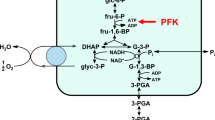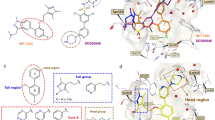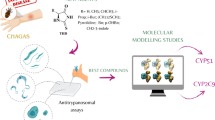Abstract
African sleeping sickness or human African trypanosomiasis, caused by Trypanosoma brucei spp., is responsible for ∼30,000 deaths each year. Available treatments for this disease are poor, with unacceptable efficacy and safety profiles, particularly in the late stage of the disease when the parasite has infected the central nervous system. Here we report the validation of a molecular target and the discovery of associated lead compounds with the potential to address this lack of suitable treatments. Inhibition of this target—T. brucei N-myristoyltransferase—leads to rapid killing of trypanosomes both in vitro and in vivo and cures trypanosomiasis in mice. These high-affinity inhibitors bind into the peptide substrate pocket of the enzyme and inhibit protein N-myristoylation in trypanosomes. The compounds identified have promising pharmaceutical properties and represent an opportunity to develop oral drugs to treat this devastating disease. Our studies validate T. brucei N-myristoyltransferase as a promising therapeutic target for human African trypanosomiasis.
This is a preview of subscription content, access via your institution
Access options
Subscribe to this journal
Receive 51 print issues and online access
$199.00 per year
only $3.90 per issue
Buy this article
- Purchase on SpringerLink
- Instant access to full article PDF
Prices may be subject to local taxes which are calculated during checkout





Similar content being viewed by others
Accession codes
References
Farazi, T. A., Waksman, G. & Gordon, J. I. The biology and enzymology of protein N-myristoylation. J. Biol. Chem. 276, 39501–39504 (2001)
Resh, M. D. Trafficking and signaling by fatty-acylated and prenylated proteins. Nature Chem. Biol. 2, 584–590 (2006)
Maurer-Stroh, S., Eisenhaber, B. & Eisenhaber, F. N-terminal N-myristoylation of proteins: prediction of substrate proteins from amino acid sequence. J. Mol. Biol. 317, 541–557 (2002)
Bhatnagar, R. S., Futterer, K., Waksman, G. & Gordon, J. I. The structure of myristoyl-CoA: protein N-myristoyltransferase. Biochim. Biophys. Acta 1441, 162–172 (1999)
Price, H. P. et al. Myristoyl-CoA: protein N-myristoyltransferase, an essential enzyme and potential drug target in kinetoplastid parasites. J. Biol. Chem. 278, 7206–7214 (2003)
Mills, E., Price, H. P., Johner, A., Emerson, J. E. & Smith, D. F. Kinetoplastid PPEF phosphatases: dual acylated proteins expressed in the endomembrane system of Leishmania . Mol. Biochem. Parasitol. 152, 22–34 (2007)
Price, H. P., Stark, M. & Smith, D. F. Trypanosoma brucei ARF1 plays a central role in endocytosis and Golgi-lysosome trafficking. Mol. Biol. Cell 18, 864–873 (2007)
Price, H. P., Panethymitaki, C., Goulding, D. & Smith, D. F. Functional analysis of TbARL1, an N-myristoylated Golgi protein essential for viability in bloodstream trypanosomes. J. Cell Sci. 118, 831–841 (2005)
Hertz-Fowler, C., Ersfeld, K. & Gull, K. CAP5.5, a life-cycle-regulated, cytoskeleton-associated protein is a member of a novel family of calpain-related proteins in Trypanosoma brucei . Mol. Biochem. Parasitol. 116, 25–34 (2001)
Denny, P. W., Gokool, S., Russell, D. G., Field, M. C. & Smith, D. F. Acylation-dependent protein export in Leishmania . J. Biol. Chem. 275, 11017–11025 (2000)
Wingard, J. N. et al. Structural insights into membrane targeting by the flagellar calcium-binding protein (FCaBP), a myristoylated and palmitoylated calcium sensor in Trypanosoma cruzi . J. Biol. Chem. 283, 23388–23396 (2008)
Selvakumar, P. et al. Potential role of N-myristoyltransferase in cancer. Prog. Lipid Res. 46, 1–36 (2007)
Georgopapadakou, N. H. Antifungals targeted to protein modification: focus on protein N-myristoyltransferase. Expert Opin. Investig. Drugs 11, 1117–1125 (2002)
Hill, B. T. & Skowronski, J. Human N-myristoyltransferases form stable complexes with lentiviral Nef and other viral and cellular substrate proteins. J. Virol. 79, 1133–1141 (2005)
Bowyer, P. W. et al. N-myristoyltransferase: a prospective drug target for protozoan parasites. ChemMedChem 3, 402–408 (2008)
Sheng, C. et al. Homology modeling and molecular dynamics simulation of N-myristoyltransferase from protozoan parasites: active site characterization and insights into rational inhibitor design. J. Comput. Aided Mol. Des. 23, 375–389 (2009)
Giang, D. G. & Cravatt, B. F. A second mammalian N-myristoyltransferase. J. Biol. Chem. 273, 6595–6598 (1998)
Panethymitaki, C. et al. Characterization and selective inhibition of myristoyl-CoA: protein N-myristoyltransferase from Trypanosoma brucei and Leishmania major . Biochem. J. 396, 277–285 (2006)
Brenk, R. et al. Lessons learnt from assembling screening libraries for drug discovery for neglected diseases. ChemMedChem 3, 435–444 (2008)
Doering, T. L. et al. An analog of myristic acid with selective toxicity for African trypanosomes. Science 252, 1851–1854 (1991)
Allen, C. L., Goulding, D. & Field, M. C. Clathrin-mediated endocytosis is essential in Trypanosoma brucei . EMBO J. 22, 4991–5002 (2003)
Hall, B., Allen, C. L., Goulding, D. & Field, M. C. Both of the Rab5 subfamily small GTPases of Trypanosoma brucei are essential and required for endocytosis. Mol. Biochem. Parasitol. 138, 67–77 (2004)
Ferguson, M. A. J. & Cross, G. A. M. Myristylation of the membrane form of a Trypanosoma brucei variant surface glycoprotein. J. Biol. Chem. 259, 3011–3015 (1984)
Ferguson, M. A. J., Low, M. G. & Cross, G. A. M. Glycosyl-sn-1,2-dimyristylphosphatidylinositol is covalently linked to Trypanosoma brucei variant surface glycoprotein. J. Biol. Chem. 260, 4547–4555 (1985)
Armah, D. A. & Mensa-Wilmot, K. S-myristoylation of a glycosylphosphatidylinositol-specific phospholipase C in Trypanosoma brucei . J. Biol. Chem. 274, 5931–5938 (1999)
Farazi, T. A., Waksman, G. & Gordon, J. I. Structures of Saccharomyces cerevisiae N-myristoyltransferase with bound myristoylCoA and peptide provide insights about substrate recognition and catalysis. Biochemistry 40, 6335–6343 (2001)
Price, H. P., Guther, M. L., Ferguson, M. A. & Smith, D. F. Myristoyl-CoA:protein N-myristoyltransferase depletion in trypanosomes causes avirulence and endocytic defects. Mol. Biochem. Parasitol. 169, 55–58 (2010)
Overath, P. & Engstler, M. Endocytosis, membrane recycling and sorting of GPI-anchored proteins: Trypanosoma brucei as a model system. Mol. Microbiol. 53, 735–744 (2004)
Engstler, M. et al. Hydrodynamic flow-mediated protein sorting on the cell surface of trypanosomes. Cell 131, 505–515 (2007)
Patterson, S. et al. Synthesis and evaluation of 1-(1-(benzo[b]thiophen-2-yl)cyclohexyl)piperidine (BTCP) analogues as inhibitors of trypanothione reductase. ChemMedChem 4, 1341–1353 (2009)
Thuita, J. K. et al. Efficacy of the diamidine DB75 and its prodrug DB289, against murine models of human African trypanosomiasis. Acta Trop. 108, 6–10 (2008)
Sienkiewicz, N., Jaroslawski, S., Wyllie, S. & Fairlamb, A. H. Chemical and genetic validation of dihydrofolate reductase-thymidylate synthase as a drug target in African trypanosomes. Mol. Microbiol. 69, 520–533 (2008)
Bowyer, P. W. et al. Molecules incorporating a benzothiazole core scaffold inhibit the N-myristoyltransferase of Plasmodium falciparum . Biochem. J. 408, 173–180 (2007)
Räz, B., Iten, M., Grether-Bühler, M., Kaminsky, R. & Brun, R. The Alamar Blue® assay to determine drug sensitivity of African trypanosomes (T.b.rhodesiense and T.b.gambiense) in vitro . Acta Trop. 68, 139–147 (1997)
Otwinowski, Z. & Minor, W. Processing of X-ray diffraction data collected in oscillation mode. Methods Enzymol. 276, 307–326 (1997)
Vagin, A. & Teplyakov, A. MOLREP: an automated program for molecular replacement. J. Appl. Cryst. 30, 1022–1025 (1997)
Murshudov, G. N., Vagin, A. A. & Dodson, E. J. Refinement of macromolecular structures by the maximum-likelihood method. Acta Crystallogr. D 53, 240–255 (1997)
Emsley, P. & Cowtan, K. Coot: model-building tools for molecular graphics. Acta Crystallogr. D 60, 2126–2132 (2004)
Schüttelkopf, A. W. & van Aalten, D. M. F. PRODRG: a tool for high-throughput crystallography of protein-ligand complexes. Acta Crystallogr. D 60, 1355–1363 (2004)
Acknowledgements
This work was supported by grants from the Wellcome Trust (WT077705, WT083481, WT077503 and WT085622), Scottish Funding Council (HR04013) and by the Translational Biology Theme of SULSA. We thank the European Regional Development Fund and the Wolfson Foundation for grants that provided relevant infrastructure for this work. The Structural Genomics Consortium is a registered charity (number 1097737) that receives funds from the Canadian Institutes for Health Research, the Canadian Foundation for Innovation and Genome Canada through the Ontario Genomics Institute, GlaxoSmithKline, Karolinska Institutet, the Knut and Alice Wallenberg Foundation, the Ontario Innovation Trust, the Ontario Ministry for Research and Innovation, Merck, the Novartis Research Foundation, the Swedish Agency for Innovation Systems, the Swedish Foundation for Strategic Research and the Wellcome Trust. We would like to thank all members of the Drug Discovery Unit for their technical assistance in this study, particularly B. Rao, I. Collie and D. James.
Author Contributions The project management team responsible for experimental design and coordination of research activities comprised S.B., R.B., A.H.F., M.A.J.F., J.A.F., I.H.G., K.D.R., D.M.F.vA., P.G.W. and D.F.S. J.A.B., M.H. and A.J.W. optimized expression and produced the active TbNMT used for screening in the Drug Discovery Unit. Biological studies were carried out by S.P.M., O.S., L.S.T., M.L.S.G., I.H. and H.P.P.; chemical syntheses by L.A.T.C. and S.B.; structural biology and modelling by D.A.R., O.G.R., C.P.M., R.H. and W.Q.; and pharmacological studies by L.S.
Author information
Authors and Affiliations
Corresponding author
Ethics declarations
Competing interests
P.G.W. and S.B. are inventors on the patent (PCT/GB2009/002084).
Supplementary information
Supplementary Information
This file contains Supplementary Figures 1-6 with legends, Supplementary Methods and Supplementary Table 1. (PDF 1132 kb)
Rights and permissions
About this article
Cite this article
Frearson, J., Brand, S., McElroy, S. et al. N-myristoyltransferase inhibitors as new leads to treat sleeping sickness. Nature 464, 728–732 (2010). https://doi.org/10.1038/nature08893
Received:
Accepted:
Issue Date:
DOI: https://doi.org/10.1038/nature08893



